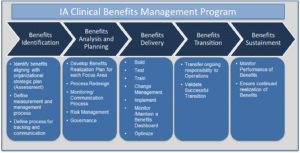Realizing Clinical Benefits: Part 3 – Planning for Success

Analogies abound related to planning for success. Consider the “Dress for Success” phenomenon of the 1990’s that has persisted to the point that every professional woman knows by heart the way to dress successfully for a job interview: gray or navy suit, cotton or silk blouse that is white or light colored, low heeled shoes, minimal makeup, minimal perfume and flawless pantyhose. In aviation, pre-flight planning is the norm. Pilots file a flight plan, check the weather, and perform a pre-flight checklist for mechanical issues prior to take off. Its purpose is to improve flight safety by ensuring that no important tasks are forgotten.
In parts one and two of this series we discussed what benefits are, some fundamental principles for success in benefits realization and some strategies for selecting the right benefits focus areas along with establishing target performance. Now we turn our attention to planning for success.
Once you’ve successfully selected your benefits focus areas, the next step is to begin planning for successful realization of benefits. That means just putting together a project plan, right? The short answer is yes. But there is much more to it. In fact, if you’ve selected 15 or so benefit focus areas then you likely are going to need to develop 15 project plans, and those individual projects will need to be managed under the larger umbrella of a benefits management program.

As a part of the global benefits management program you’ll need to develop standardized processes for measurement of key performance indicators along with defining processes for tracking progress toward goals and communicating progress to key stakeholders. All of these are pretty standard for project and program management, so they likely won’t present too many challenges.
Essential to the project planning process for each focus area is an understanding of the key elements that contribute to outcomes. Let’s turn back to our aviation analogy for a moment. Did you know that pilot impairment contributes to many more accidents than failure of aircraft systems? As a frequent flier, I often worry about potential mechanical system problems, but rarely do I think twice about pilot problems. After several reports of impaired pilots attempting to fly commercial aircraft while impaired this week, perhaps it’s time to rethink that.
Similarly, few benefits realization plans have ever failed because the project plan was inadequate, the KPI measurement plan was lacking or targets were a bit off. In fact, those things can be pretty easily tweaked along the way. It’s the other elements critical to success that will “crash the plane.” Effective governance, appropriate process redesign, robust operational readiness activities and a comprehensive change management program are the true keys to success. Leave them out and you won’t get the job done.
Effective governance is critical because there are decisions that must be made around standardization, process redesign, KPIs and KPI targets and a host of other areas. Putting together effective governance is the first opportunity for operations to “own” the success of your project. It is also an opportunity to begin the process of engaging operational leaders, who ultimately will need to bring along their subordinates. By having operational leaders make these decisions, in collaboration with IT, you’ll be gaining buy in and getting a head start on ultimately being able to turn benefits management over to operations for sustainment. Establishing effective governance also makes it crystal clear to the project team who is empowered to make decisions and how to direct dissenters.
As with any new implementation, process redesign is inherently a part of success. One of the first needs will be to decide who will be involved in process redesign. For instance, if your organization has a process improvement team, you’ll likely want them involved. The team will also need to include membership from operations and IT and potentially other areas. The ultimate goal of a process redesign team will be to not only streamline processes to achieve desired outcomes, but also to identify potential areas for technology enablement.
Operational Readiness and Change Management prepares leadership and users for the implementation. What’s involved? For starters you’ll need to address any policies and procedures that need to change. You’ll need to develop a robust communication plan so that the benefits realization vision as well as associated goals are transparent to all stakeholders and stakeholders understand their accountability for achievement of those goals, both current and future. You’ll need to address hesitation and identify the “what’s in it for me”. Finally you’ll need to plan for training that that address role based needs.
So, back to dressing for success. The best suit, shoes and makeup might get you in the door, but they are not going to get you the job. The only way to land the job is knowing the details of what’s necessary to actually do the job. Similarly, the only way to successfully plan for realization of benefits is to understand the essential elements of success.
To learn more about benefits realization download the Impact Advisors white paper Realizing Clinical Benefits from EHR Investments.
























